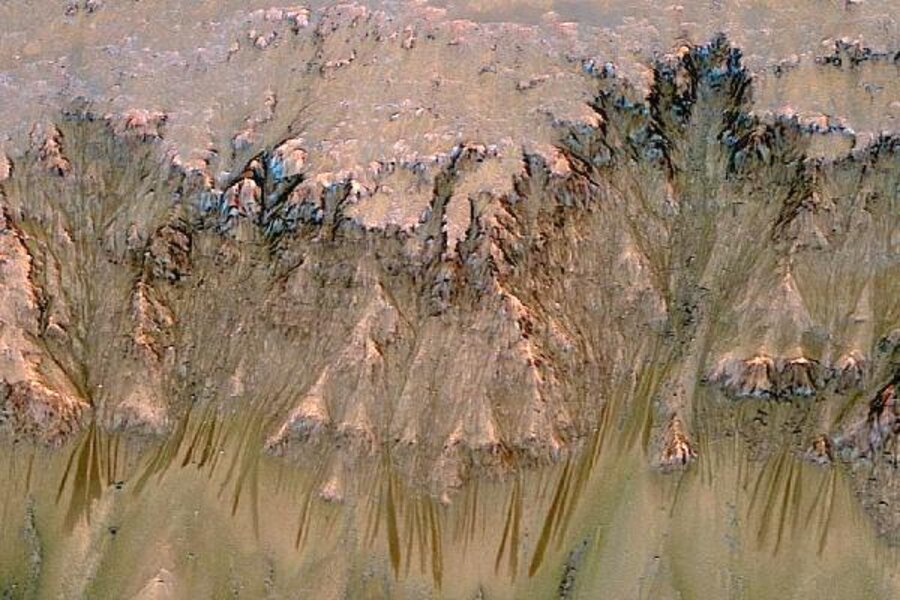Scientists find 'best evidence' yet for liquid water now on Mars
Loading...
Liquid water – a necessary ingredient for organic life – may finally have revealed its presence on today's Mars.
Images unveiled today from NASA's Mars Reconnaissance Orbiter have revealed dark, narrow streaks that appear and slowly snake down walls of craters that populate the planet's southern hemisphere. The process occurs from late spring to early fall. The streaks vanish with the return of late fall and winter, only to reappear the following spring.
The streaks originate at rock outcroppings high on steep crater walls, but only on walls facing in the general direction of the equator, which receive more sunlight than poleward-facing slopes.
The features are too narrow to be formed by silt sliding downhill, which has been seen elsewhere on the planet, according to the team of scientists formally reporting the observations in the Aug. 5 issue of the journal Science. Moreover, these streaks are far more rare than the silt slides, suggesting a far less common process at work.
Sudden thaws of carbon-dioxide frost probably triggered those other, silty slides, scientists have theorized. These newly-discovered features, by contrast, appear – and grow – when surface temperatures are too warm for carbon-dioxide frost to exist. Those temperatures range from about 9 degrees below zero Fahrenheit to as high as 80 degrees F during a summer's mid-afternoon. Nine degrees below zero may be too warm for CO2 frost, but not for liquid water heavily laced with salts, says Alfred McEwen, a planetary scientist at the University of Arizona at Tucson and leader of the team reporting the results.
He cautions that the evidence for liquid water as the driver behind these ephemeral stripes is circumstantial. So far, the orbiter's spectrometer has not detected the chemical fingerprints of water in these features, although the team has plans to use the spectrometer's high-resolution option to hunt for them in greater detail than the initial, low-resolution measurements could achieve.
Circumstantial? Yes, others say, but important.
"This is the best evidence we have to date of liquid water occurring today on Mars," says Philip Christiansen, a researcher at Arizona State University at Tempe and a lead scientist on an earlier mission, the Mars Odyssey orbiter.
For 15 years, NASA has geared its Mars exploration program to "follow the water," in order to determine how hospitable the red planet was to at least simple forms of life early in its history, and perhaps today as well.
Over this period, orbiters and landers alike have found ample evidence of a watery past for Mars, a story told through the minerals spread across the martian surface. Missions also have detected vast quantities of water locked up as ice at the planet's poles, or underground at higher latitudes.
As time has passed, evidence also has grown that features on the planet's surface have been shaped periodically by liquid water during its recent geological history, notes Bruce Jakosky, director of the Center for Astrobiology at the University of Colorado at Boulder.
But the question remained: Does liquid water – and by extension, potential habitats for microbial life – exist on Mars today?
"Liquid water is the most plausible explanation for these features," Dr. Jakosky says. If the team's interpretation withstands additional tests, "it would have significant astrobiological implications," namely, potential habitats.
What might the Martian habitats look like? Lisa Pratt, a biogeochemist at Indiana University, points to features in Siberian permafrost as an example. Deep in the permafrost, researchers have discovered small pockets of liquid brine surrounded by frozen tundra. The brine's high salt content keeps the pockets, dubbed cryopegs, from freezing.
One could imagine similar features on Mars, below the surface near where the streaks have been detected. Some of them could be close enough to the surface that during summer, the premafrost thaws enough to liberate the brine in the pockets, which could then migrate through fissures in the ground.
Images of the streaks come from the Mars Reconnaissance Orbiter's HiRISE camera, which can pick out features on the Martian surface as small as one foot across. The stripes identified in this study range from about 1.5 feet to 16 feet wide.
So far the team has identified seven sites – and at least 20 more candidate sites – where these dark stripes appear and disappear seasonally.
One confirmed site is Newton Crater, roughly 180 miles across, in the southern mid-latitudes. The crater hosts about 1,000 stripes each warm season, although they vary in location and length from one year to the next.
The amount of water painting these stripes is likely to be small, McEwen says. Lab experiments suggest that what the team sees in Newton Crater is being driven by a couple of swimming pool's worth of brine.
He and his colleagues can't completely rule out other explanations for the features yet, he acknowledges. And they can't fully explain the mechanism responsible for releasing the moisture or causing the darkening of the stripes.
Still, the results are giving researchers a more-focused set of regions to observe with future missions for evidence of life.
"We've needed a way to focus our efforts and think about the engineering decisions that need to be made for future landed missions or orbiting mission. I really think we now have it," says Dr. Pratt.





